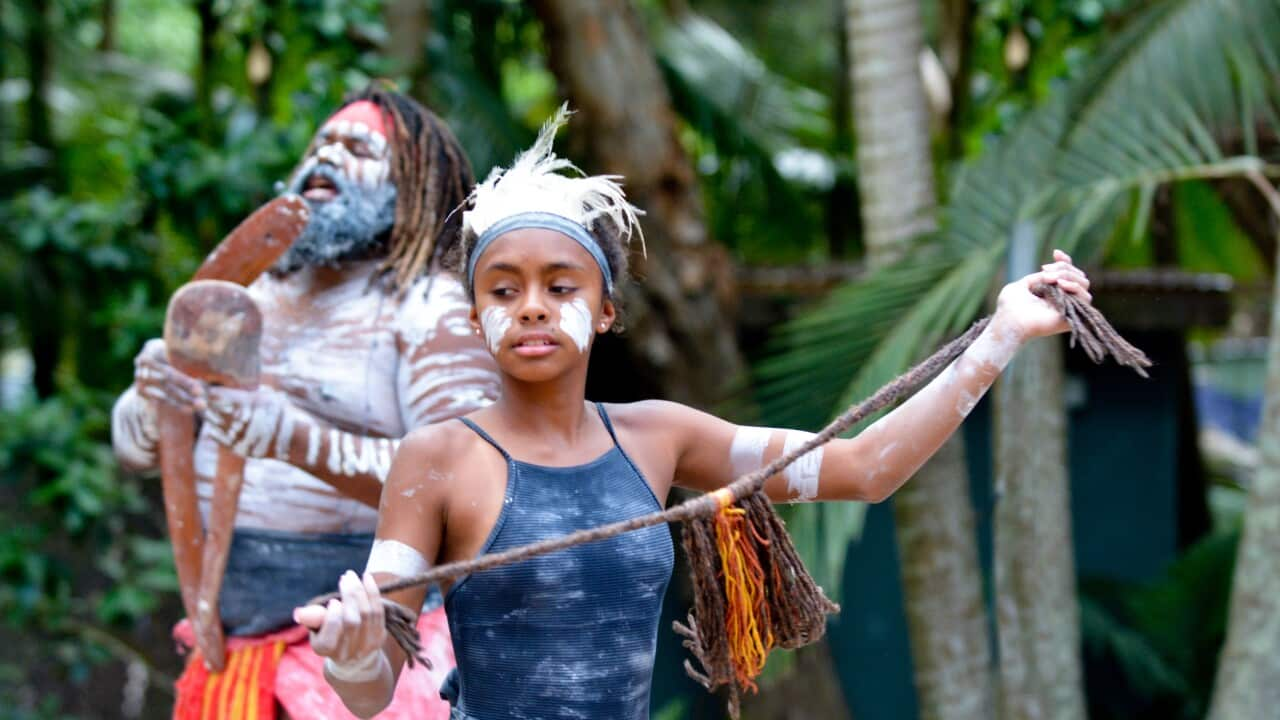Under a canopy of twinkling stars and through innumerable cycles of the Moon, the culture and presence of Australia’s First Nations people stretches back through thousands of years.
From the marvel of the Milky Way galaxy, to meteors, and the different phases of the Moon – there is lots to learn about Indigenous astronomy and star knowledge.
Looking up into the night sky, we see a beautiful array of stars twinkling amongst the ever-changing phases of the moon after the daily progression of the sun.
Astronomy is the study of celestial objects and phenomena, and Indigenous astronomy refers to deep knowledge of the stars and their connections to the land – understanding that everything on the land is reflected in the sky.
For Aboriginal and Torres Strait Islander people, the sky informs cultural practices that have been handed down through oral tradition over thousands of generations, in the form of stories, songs, ceremony, and art.

Moon over the Sydney Harbour Bridge – image Eclipse Chasers.
“For more than 60,000 years First Nations people have looked up to the sky, it helps us understand the world around us, using our observation of the stars, the planets, the moon, the sun and the atmosphere, to predict weather changes and tides, to navigate on land and water, and to plan food gatherings, hunting, trading or ceremony, as well as pass down stories through the generations,” Aunty Joanne explains.
Indigenous star knowledge is a way for First Nations people to understand the world in which they live and their roles and responsibilities within it.
“We have a saying – everything that’s up there is down here. So you can find your community, song lines, important ceremonial sites and other way-finding points using the stars – but the stars alone, need a little bit of help for you to understand everything, so knowing your dance, knowing your language, and your area's connection to your piece of country - validates everything,” Aunty Joanne says.
Duane Hamacher is Associate Professor of Cultural Astronomy in the School of Physics at the University of Melbourne. He works with Aboriginal and Torres Strait Islander communities to document and share their traditional knowledge.
The elders explain that everything in the sky is connected to the land. So, if you want to know how the world around us works, you must look to the stars.Duane Hamacher.
“Humans have always held a close connection with the sky. The stars help us understand space and time. They inform law and science. They serve as a map and a timepiece. And they function as a powerful memory space, enabling people to pass down knowledge – uncorrupted - for thousands of years,” Duane Hamacher says.
Everything in the sky has meaning and purpose. The movements of the Sun, Moon, and stars are used to predict changes in our local environment, such as seasons, weather patterns, and the behaviour of plants and animals.

The Australian sky at night - Image Ken Cheung.
“If you want to know when it is going to rain, look up. If you want to mark out the behaviour cycles of animals or know when to plant or harvest gardens or food sources, look up. You must learn to read the stars and your environment to understand what it is telling you.”
This holistic way of looking at the world is central to Aboriginal and Torres Strait Islander culture, says Duane Hamacher.
“In the Torres Strait, elders teach how to observe the ways stars twinkle. If you can read them - which means observing and interpreting changes in their properties, such as their colour, sharpness, or how fast they twinkle – you will learn important things about the atmosphere. This can tell you if a storm is coming or if the trade-winds are shifting,” Duane Hamacher explains.
Every night, the stars rise in the eastern sky four minutes earlier than the day before. Over the course of a year, the stars come full circle as the Earth moves around the Sun.
This cycle of celestial change coincides with changes on the land. As Aunty Joanne explains, the Emu in the Sky, or the Dark Emu, is a well-known constellation that is outlined by the dark areas in the Milky Way.
“What I like about the Emu in the sky is it shows others how First Nations people use the dark patches in the sky as much as the stars, but also because it mirrors the behaviour of the terrestrial emu, so whatever we see the terrestrial emu doing on the land, we also see that information paralleled in the sky.”

The Dark Emu rising - Image Geoffrey Wyatt.
“This coincides with the time of the year that the emus are breeding,” Duane Hamacher says.
“As the months pass, the Dark Emu is high overhead by June and July. This is the time male emus are sitting on the eggs. When the Emu shifts around to being perpendicular to the southwestern horizon in August and September, the chicks begin hatching.”
The celestial Emu, featured in the traditional stories passed down by First Nations people, records important scientific information.
“Gunaikurnai elders of southern Victoria tell how the Moon man was hunting an emu. The emu tried to escape by running across a tree that was laying over a river. But it slipped and fell into the water. Today you can see the story illustrated in the sky. The silhouette of the emu lies in the sky river - the Milky Way or Warrambool,” Duane Hamacher explains.
“The Yarran tree lying across the river is the Southern Cross, next to the head of the emu. When the Moon man comes out, the emu hides away from the hunter. This is describing how the natural light pollution of the Moon, whose bright light washes out the detail in the Milky Way, makes the emu difficult to see.”
Transient phenomena in the night sky, such as meteors - also have meaning in Indigenous cultures.

Aunty Joanne Selfe - Image supplied. Associate Professor Duane Hamacher, image – Amanda Fordyce.
“Across much of northern Australia, bright meteors are related to evil spirits beings. Meteors represent these long spindly entities that fly across the sky. In the Torres Strait, bright meteors are called Maier. Elders explain that they represent the spirits of people who've just passed away, traveling across the sky like a rocket to Beig, the land of the dead,” Mr Hamacher says.
The relationship between Aboriginal and Torres Strait Islander people and the stars encompasses a sense of identity and belonging – to the natural world, their sense of being and to their culture.
In First Nation’s astronomy, the origins of the universe go back, way way back to the Tjukurrpa. Westerners refer to that as the Dreaming, but basically, it’s the time long long ago, when all of what exists came to be.Aunty Joanne
“But what’s interesting in this history is that neither time nor history as we understand it is involved in the meaning, you see we have a concept – and that’s called everywhen, and just as a spirit people roamed the earth and made the mountains, the river and the sky and all the celestial objects that we see around us, it lets you have a glimpse into an understanding that we are in fact co-creators of the universe in which we live - the observer and the observed are the same," Aunty Joanne explains.
In this way, Indigenous star knowledge is an integral part of linking the past, present, and future into a holistic system of knowledge, which is central to First Nations culture.
Subscribe or follow the Australia Explained podcast for more valuable information and tips about settling into your new life in Australia.











